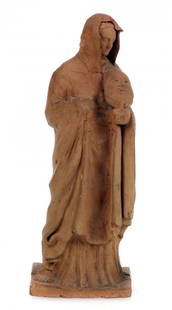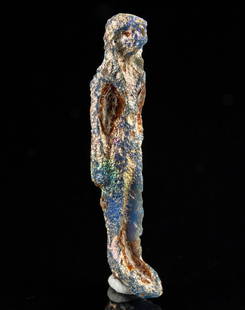
Female figure "malagan" - Papua New Guinea - Bismarck Archipelago - New Ireland- Simberi (Tabar
Similar Sale History
View More Items in Figurines & StatuettesRelated Figurines & Statuettes
More Items in Figurines & Statuettes
View MoreRecommended Decorative Objects
View More










Item Details
Description
wood, lime, red ochre, black pigment, shell inlay, fibres (web), handwritten inventory no. "62884" - "L.923 b / 206" - "Haug", in second place "62.884", labelled "a...lá" (illegible) in graphite, rest., base
According to friendly information from Ulrich Menter, curator of the Oceania collection at the Linden-Museum, the details from the inventory book of the Museum are as follows: "Neu-Mecklenburg-O., Fischer Insel (Simberi)". "62884" (inventory number). "L.923 b / 206" (number of acquisition list). According to the inventory book, "Carl Haug, Friedrich-Wilhelms-Hafen", gave the figure to the museum as a gift in 1909. According to the inventory book entry, the illegible inscription on the object reads: "a ula, Kap Kap ven abi Kauf Kauf - ta vater Kauf Kauf - ". According to the entry, the figurine was given in exchange to Arthur Speyer in 1965.
This figure is particularly elaborately designed and painted. It is surrounded by an open-worked filigree encasing of animal depictions, struts and feather-like ornaments. The figure holds a bird with outstretched wings in front of her with both hands. Her breasts have the shape of bird heads. She is flanked and backed by flying fish embracing them with outstretched fins.
Birds and fish are a common motif in Malagan carvings, but their meaning is uncertain. It is assumed that they represent supernatural beings associated with specific clans.
The "malagan" carvings of northern New Ireland, the northeasternmost province of Papua New Guinea, are among the most intricate sculptures in Oceania.
The term "malagan" refers to a complex series of ceremonies and the visual art forms associated with them.
"Malagan" rites mark almost all the important stages in the lives of the inhabitants of New Ireland. Throughout life, individuals seek to acquire rights to specific "malagan" images and the rituals associated with them. Men, in particular, compete to obtain rights to the greatest number of "malagan", possession of which confers status and prestige.
The most spectacular "malagan" carvings are created and displayed during the final memorial ceremony honoring the deceased, which, due to the great expense and extensive preparations involved, often occurs months or years after a person's death. The aim of this ceremony is to "finish the dead". This is done by remembering him with all his achievements for one last time - and then forgetting him. This approach requires that all of the deceased's legal and personal matters be settled, that his land and other rights be transmitted, and that his positions in clan and community be taken over by successors. On a more esoteric note, it includes the recapturing of his life force, the energy of which is thought to reside in the "malagan" objects during the festival, and to be dispersed and activated among the participants at the end of the ceremony.
The feast includes the construction of a "malagan" house for the presentation of the art objects, the appearance of masked dancers at dawn, the exchange of larger quantities of shell money, the feasting on large amounts of taro, pork and bananas and the slaughtering of a vast numbers of pigs that are presented in front of the "malagan"house while respected elders offer speeches and preside over the ritual exchange that closes the ceremony.
Afterwards, the "malagan" carvings, having served their purpose, are destroyed, allowed to rot, or sold to outsiders. This final dismissal marks the “finishing” of the dead, when all the work of mourning and customary obligations has been settled. The dead are "sent away to biksolwara”—to the deep sea, where everything has come from and to where everything eventually returns.
H: 93 cm, H: 36,6 inch
Provenance:
Carl Haug, Friedrich-Wilhelms-Hafen (Madang), Papua New Guinea
Linden-Museum, Stuttgart, Germany (1909)
Arthur Speyer, Berlin, Germany (1965)
Ludwig Bretschneider, Munich, Germany
Munich Private Collection
The figure was collected by Carl Haug, who worked in German New Guinea as captain on the North German Lloyd steamer "Siar", which was launched in 1902. He sailed the "Siar" in rotation with Captain Hermann Voogdt and Alfred Knoth, both of whom were also enthusiastic collectors of ethnographic artefacts.
According to friendly information from Ulrich Menter, curator of the Oceania collection at the Linden-Museum, the details from the inventory book of the Museum are as follows: "Neu-Mecklenburg-O., Fischer Insel (Simberi)". "62884" (inventory number). "L.923 b / 206" (number of acquisition list). According to the inventory book, "Carl Haug, Friedrich-Wilhelms-Hafen", gave the figure to the museum as a gift in 1909. According to the inventory book entry, the illegible inscription on the object reads: "a ula, Kap Kap ven abi Kauf Kauf - ta vater Kauf Kauf - ". According to the entry, the figurine was given in exchange to Arthur Speyer in 1965.
This figure is particularly elaborately designed and painted. It is surrounded by an open-worked filigree encasing of animal depictions, struts and feather-like ornaments. The figure holds a bird with outstretched wings in front of her with both hands. Her breasts have the shape of bird heads. She is flanked and backed by flying fish embracing them with outstretched fins.
Birds and fish are a common motif in Malagan carvings, but their meaning is uncertain. It is assumed that they represent supernatural beings associated with specific clans.
The "malagan" carvings of northern New Ireland, the northeasternmost province of Papua New Guinea, are among the most intricate sculptures in Oceania.
The term "malagan" refers to a complex series of ceremonies and the visual art forms associated with them.
"Malagan" rites mark almost all the important stages in the lives of the inhabitants of New Ireland. Throughout life, individuals seek to acquire rights to specific "malagan" images and the rituals associated with them. Men, in particular, compete to obtain rights to the greatest number of "malagan", possession of which confers status and prestige.
The most spectacular "malagan" carvings are created and displayed during the final memorial ceremony honoring the deceased, which, due to the great expense and extensive preparations involved, often occurs months or years after a person's death. The aim of this ceremony is to "finish the dead". This is done by remembering him with all his achievements for one last time - and then forgetting him. This approach requires that all of the deceased's legal and personal matters be settled, that his land and other rights be transmitted, and that his positions in clan and community be taken over by successors. On a more esoteric note, it includes the recapturing of his life force, the energy of which is thought to reside in the "malagan" objects during the festival, and to be dispersed and activated among the participants at the end of the ceremony.
The feast includes the construction of a "malagan" house for the presentation of the art objects, the appearance of masked dancers at dawn, the exchange of larger quantities of shell money, the feasting on large amounts of taro, pork and bananas and the slaughtering of a vast numbers of pigs that are presented in front of the "malagan"house while respected elders offer speeches and preside over the ritual exchange that closes the ceremony.
Afterwards, the "malagan" carvings, having served their purpose, are destroyed, allowed to rot, or sold to outsiders. This final dismissal marks the “finishing” of the dead, when all the work of mourning and customary obligations has been settled. The dead are "sent away to biksolwara”—to the deep sea, where everything has come from and to where everything eventually returns.
H: 93 cm, H: 36,6 inch
Provenance:
Carl Haug, Friedrich-Wilhelms-Hafen (Madang), Papua New Guinea
Linden-Museum, Stuttgart, Germany (1909)
Arthur Speyer, Berlin, Germany (1965)
Ludwig Bretschneider, Munich, Germany
Munich Private Collection
The figure was collected by Carl Haug, who worked in German New Guinea as captain on the North German Lloyd steamer "Siar", which was launched in 1902. He sailed the "Siar" in rotation with Captain Hermann Voogdt and Alfred Knoth, both of whom were also enthusiastic collectors of ethnographic artefacts.
Condition
See description
Buyer's Premium
- 30%
Female figure "malagan" - Papua New Guinea - Bismarck Archipelago - New Ireland- Simberi (Tabar
Estimate €20,000 - €30,000
12 bidders are watching this item.
Shipping & Pickup Options
Item located in Wurzburg, Bavaria, deOffers In-House Shipping
Local Pickup Available
Payment

Auction Curated By

Expert for African and Oceanic Art

Expert for Pre-Columbian and Classical Antiquities
TOP











































































